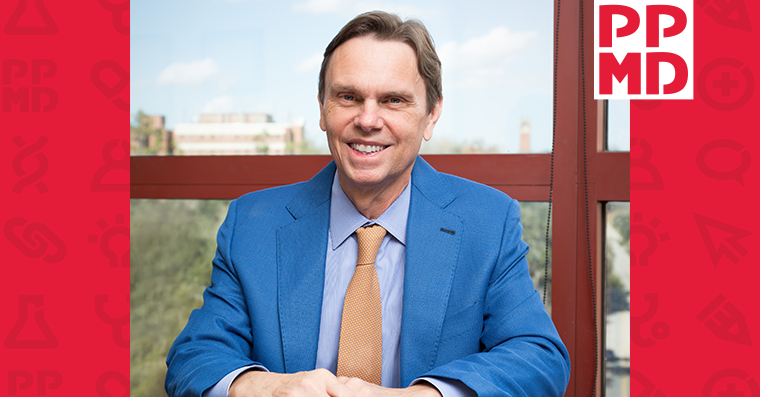
PPMD is pleased to award the University of Florida (UF) Wellstone Muscular Dystrophy Cooperative Center a grant for $348,891. The project titled “Understanding and Improving AAV Gene Therapy for DMD” is led by H. Lee Sweeney, Ph.D., director of the UF Myology Institute and the Thomas H. Maren, M.D., eminent scholar chair in pharmacology and therapeutics in the UF College of Medicine. Dr. Sweeney has been the director of a Wellstone Center (one of the six) since 2005, which he relocated to the University of Florida in 2015.
COVID-19 has impacted many areas of research, including the allocation of funds at National Institutes of Health (NIH), which resulted in a tighter budget than previous years. This bridge grant provides supplemental funding to allow the continued collection of data at the University of Florida until the Wellstone Center can apply for a renewal in the summer of 2021.
Understanding Duchenne
Duchenne is caused by a change in the dystrophin gene that leads to an absence of the dystrophin protein. A prominent feature of the disease is a constant cycle of muscle breakdown and repair. Overtime this continual state of muscle degeneration and regeneration leads to fibrosis and the development of scar tissue. The impacts are also seen in the heart muscle, with heart failure as the leading cause of death in Duchenne.
Gene therapy holds the promise of providing benefit to patients by delivering the instructions for how to make a micro-dystrophin protein to the muscle cells, where no dystrophin is produced.
While this strategy may become a treatment option for some patients, for those individuals without access to gene therapies, there will remain a need to alter the inflammatory and fibrotic processes that result in decreased regeneration of skeletal muscle and cardiac dysfunction. Additionally, in older patients where there may be more fibrosis, the strategy for delivering gene therapy may need to be altered to ensure successful delivery.
Finally, while the potential benefits of micro-dystrophin in skeletal muscle are well understood, more research needs to be done to understand the impacts of micro-dystrophin on the heart.
Dr. Sweeney’s Research
In this project, Dr. Sweeney and his team at the University of Florida will evaluate ways to improve the delivery of gene therapy in disease with considerable fibrosis. Dr. Sweeney will also investigate if there are differences in how the loss of dystrophin impacts skeletal muscle compared to cardiac muscle and what this means for micro-dystrophin gene therapy.
This information will potentially help inform the design of gene therapy and/or drug therapies to treat the hearts of people living with Duchenne, in a way that is independent of, or complementary to, gene therapy.
Eric Camino, PhD, PPMD’s Vice President of Research and Clinical Innovation, explains:
“These are promising times for research into Duchenne, and we could not let the COVID-19 pandemic threaten our momentum. At the height of the pandemic, PPMD developed bridge grants to serve as an emergency temporary funding source so that key projects, personnel, or infrastructure may be preserved. The work Dr. Sweeney is doing is integral to our understanding of how best gene therapy can be delivered to older patients and will be crucial for evaluating the impact of micro-dystrophin on the heart.”
As Dr. Sweeney describes:
“PPMD and I are in agreement with the critical need to better understand the impact of emerging AAV-micro-dystrophin therapies, especially in the heart. If not for this bridge funding, we would have lost a year of progress while we await the decision from NIH on whether or not the NIH will continue to fund this work via our Wellstone Center. We owe the patients the best possible therapy that can be provided, so we need a thorough evaluation of the plusses and minuses of the current and future AAV treatment strategies.”
The Wellstone Muscular Dystrophy Research Network
One of PPMD’s signature legislative achievements includes the passage of the 2001 Muscular Dystrophy Community Assistance Research & Education Act (MD-CARE Act) that mandated federal attention to all of the muscular dystrophies and led to the creation of scientific Centers of Excellence, named after the late Senator Paul D. Wellstone, across the country to accelerate muscular dystrophy research. In 2015, the University of Florida was designated by the NIH as one of six Wellstone Centers to help translate scientific findings into strategies to improve the lives of muscular dystrophy patients.
Speaking to the importance of the Wellstone Centers, Camino explains:
“The Wellstone Centers of Excellence play a vital role in the success of many Duchenne and Becker research projects as the core facilities at each center provide invaluable resources for academic and clinician researchers. The important work of the UF Wellstone Center is an essential component of the research PPMD supports.”
Every year our community heads to Washington, D.C. as part of PPMD’s Advocacy Conference to communicate to Congress the need for continued funding for the federal agencies that impact Duchenne. Along with the funding, we also request that Congress include Duchenne-specific “report language” which includes specific priorities and guidance for Duchenne-related spending. This year, PPMD’s Advocacy Conference is being held virtually on March 10th — and there’s still time to register and make your voice heard!
Join PPMD’s Virtual Advocacy Conference >PPMD’s Research Strategy & Investments
Part of PPMD’s ongoing Gene Therapy and Cardiac Initiatives, we are especially grateful to John Owens Adventure, Inc., a family foundation and longtime PPMD collaborator that raises awareness and supports Duchenne research, for their generous contribution toward this project.
Ending Duchenne means attacking the disease with multiple approaches from multiple angles and with your support we will continue to not only explore the most promising treatments, we will do it while protecting the hearts and muscles of our loved ones. To learn more about our robust Research Strategy, funding initiatives and strategies for accelerating drug development, click here.



 by: Parent Project Muscular Dystrophy
by: Parent Project Muscular Dystrophy

